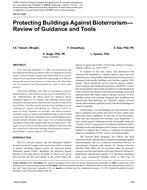Description
Ever since the September 11, 2001, terrorist attacks and the subsequent anthrax incidents in the US, attempts have been made to thwart further attacks and other forms of terrorism. Attacks involving chemical and/or biological agents (CBA) are among the most dreaded because of the ease with which they can be produced and disseminated as well as their fatal potency.
Protecting buildings and built-in environments against bioterrorism or CBA attacks are key issues in homeland security. Unfortunately, the threat posed by chemical and/or biological agents is so complex that building professionals should be educated about what they are, possible scenarios of their release, how they may be detected, how buildings may be “immunized†against such threats, etc. Terrorists will try to cause as many casualties as possible, with high-occupancy structures such as commercial buildings being at elevated risk in any such CBA release. Building owners and building professionals should, therefore, have some level of understanding and appreciation of the dangers that such an attack poses. This paper reviews some of the necessary guidance and tools that are available for educating building professionals on protecting building occupants against CBA attacks.
Units: Dual
Citation: ASHRAE Transactions, Vol. 113, pt 1, Dallas 2007
Product Details
- Published:
- 2007
- Number of Pages:
- 10
- File Size:
- 1 file , 110 KB
- Product Code(s):
- D-DA-07-029




